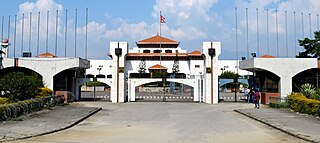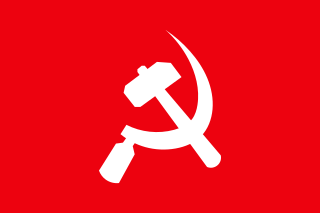
The politics of Nepal functions within the framework of a parliamentary republic with a multi-party system. Executive power is exercised by the Prime Minister and their cabinet, while legislative power is vested in the Parliament.

The NepaleseCivil War was a protracted armed conflict that took place in the then Kingdom of Nepal from 1996 to 2006. It saw countrywide fighting between the Kingdom rulers and the Communist Party of Nepal (Maoist), with the latter making significant use of guerrilla warfare. The conflict began on 13 February 1996, when the CPN (Maoist) initiated an insurgency with the stated purpose of overthrowing the Nepali monarchy and establishing a people's republic; it ended with the signing of the Comprehensive Peace Accord on 21 November 2006.

Pushpa Kamal Dahal, alias Prachanda, is a Nepalese politician, currently serving as the Leader of the Opposition, since July 2024. He has served as the Prime Minister of Nepal on three separate occasions, from 2008 to 2009 as the first prime minister of the Federal Democratic Republic of Nepal, from 2016 to 2017, and again from 2022 to 2024.

Baburam Bhattarai, also known by his nom de guerre Laaldhwoj, is a Nepalese politician, architect and former Prime Minister who presently serves as leader of the Nepal Socialist Party.

The Communist Party of Nepal (Maoist Centre) (Nepali: नेपाल कम्युनिस्ट पार्टी (माओवादी केन्द्र), romanized: Nēpāla Kamyunisṭa Pārṭī (Mā'ōvādī Kēndra)), abbreviated CPN (Maoist Centre) or CPN (MC), is the third largest political party in Nepal and a member party of Samajbadi Morcha. It was founded in 1994 after breaking away from the Communist Party of Nepal (Unity Centre). The party launched an armed struggle in 1996 against the Nepalese government. In 2006, the party formally joined mainstream politics after signing a peace agreement following the 2006 Nepalese revolution.

The Communist Party of Nepal (Unified Marxist–Leninist) (Nepali: नेपाल कम्युनिष्ट पार्टी (एकीकृत मार्क्सवादी-लेनिनवादी), romanized: nēpāl kamyuniṣṭ pārṭī (ēkīkṛt mārksavādī-lēninavādī); abbr. CPN (UML)) is a communist political party in Nepal. The party emerged as one of the major parties in Nepal after the end of the Panchayat era.

Sher Bahadur Deuba is a Nepali politician and former prime minister of Nepal. He has also been serving as the president of the Nepali Congress since 2016. Deuba has served five terms as prime minister and is the Member of Parliament for the parliamentary constituency of Dadeldhura 1.

The Nepal Workers Peasants Party (NWPP), also known as the Nepal Workers' and Peasants' Party and the Nepal Majdoor Kisan Party, is a communist political party in Nepal. The party was founded on 23 January 1975 by Narayan Man Bijukchhe and draws most of its support from Bhaktapur. The party is sympathetic to the Workers' Party of Korea and has declared Juche to be a "directional ideology".

The Communist Party of Bhutan (Marxist–Leninist–Maoist) (abbr. CPB (MLM)) is an underground communist party in Bhutan.

The Nepalese democracy movement was the combination of a series of political initiatives and movements from the 20th century to 2008 that advocated the establishment of representative democracy, a multi-party political system and the abolition of monarchy in Nepal. It has seen three major movements, the Revolution of 1951, Jana Andolan and Loktantra Andolan which ultimately abolished the Shah monarchy, transitioned Nepal towards a republic and reintroduced multi-party bicameral democracy.
Young Communist League, Nepal is the youth wing of Communist Party of Nepal. The president of YCL is Subodhraj Serpali and the general secretary of YCL is Ganesh Shahi. The Young Communist League (YCL) was formed by the CPN–Maoist at some point during the 'people's war' to support the revolution. Ganeshman Pun, Former chairman of the YCL, has stated that the League was reactivated in November 2006. According to him, the YCL "is a fusion of the Party's military and political character, and it is composed of PLA members who have an interest in politics." As the party's youth wing, its role is to "organise youth, be involved in events, conduct political awareness, and take part in development work as volunteers." Once the CPN-Maoist was proscribed, the YCL was also forced underground. After the April 2006 Jana Andolan and the subsequent over-ground role of the insurgents, the CPN-Maoist revived the YCL.

General Rookmangud Katawal is a former Nepalese Army general, who served as the Chief of Army Staff of the Nepal Army from 2006 to 2009. General Katawal has come across controversy after the then Prime Minister Pushpa Kamal Dahal unilaterally decided to sack him on May 3, 2009.
The Comprehensive Peace Accord was signed on 21 November 2006 between the Government of Nepal and the Communist Party of Nepal —at the time known as the Communist Party of Nepal (Maoist).

Rekha Thapa is a Nepalese is a renowned Nepalese actress, politician, filmmaker, and social activist, celebrated for her significant contributions to the Nepali film industry and her unwavering advocacy for women's empowerment. Over her two-decade-long career, she has appeared in over 200 films, many of which spotlight strong female protagonists and address pressing social issues. She won the CG Digital Film Awards for Best Actress, and in 2011 she also won the NEFTA Film Awards for Best Actress.

Khadga Prasad Sharma Oli, commonly known as K. P. Sharma Oli or simply K.P. Oli, is a Nepalese politician who is serving as the prime minister of Nepal since 15 July 2024.
Barsaman Pun, also known by his nom de guerreAnanta, is a Nepali communist politician and former Minister for Energy, Water Resources and Irrigation.

The Second Oli cabinet, also known as the Oli cabinet, 2018, was the Government of Nepal from 15 February 2018 to 13 July 2021. It initially formed as a majority coalition on 15 February 2018, after Khadga Prasad Sharma Oli was elected as the new Prime Minister of Nepal following the 2017 general election. Oli's candidacy was supported by the Communist Party of Nepal and the Communist Party of Nepal. He assumed his office with two ministers and the remaining ministers were added at later points. The CPN withdrew its support from the government in May 2021, reducing it to a minority, and after the dissolution of the House of Representatives, it turned into an interim government. The cabinet was replaced by the fifth Deuba cabinet, formed after the Supreme Court ordered the appointment of Nepali Congress president Sher Bahadur Deuba as prime minister under Article 76 (5) of the Constitution of Nepal.

Communism in Nepal traces its roots back to the pro-democracy movement of 1951, and the subsequent overthrow of the autocratic Rana regime and the establishment of democracy in Nepal. The communist movement in Nepal has split into factions multiple times and multiple factions have come together into a single fold at times as well. It has a history of getting banned from open political discourse, as well as multiple instances of embracing guerrilla insurgency, most notably, the Maoist insurgency in the 1990s and early 2000s that led to the Nepalese Civil War, claiming at least 17,000 lives.
Amrita Thapa is a Nepali communist politician, a former Maoist insurgent, coordinator of the Women Wing of the ruling Nepal Communist Party (NCP), and member of the Nepal House of Representatives of the federal parliament of Nepal, elected under the proportional representation system.
Kamala Roka is a Nepali communist politician, former sports minister and a member of the House of Representatives of the federal parliament of Nepal.














